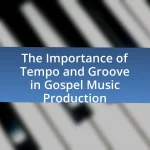The article focuses on the critical role of dynamics in gospel music production and its impact on emotional expression. It explores how variations in volume, intensity, and articulation enhance the listener’s emotional experience, allowing for a deeper connection with the music. Key elements such as volume levels, silence, and instrumentation are discussed, along with techniques used by producers to manipulate dynamics effectively. The article also examines the psychological effects of dynamics on listeners and offers practical tips for maintaining balance in dynamic levels, ultimately emphasizing the importance of dynamics in creating impactful gospel music.

What is the role of dynamics in gospel music production?
Dynamics in gospel music production play a crucial role in conveying emotional depth and intensity. The variation in volume and intensity helps to highlight key moments in the music, allowing for a more profound connection with the audience. For instance, softer passages can evoke introspection and reverence, while louder sections can inspire joy and celebration. This dynamic contrast is essential in gospel music, as it reflects the emotional journey often depicted in the lyrics and enhances the overall worship experience. Studies in music psychology indicate that dynamic changes significantly influence listeners’ emotional responses, reinforcing the importance of dynamics in creating impactful gospel music.
How do dynamics influence emotional expression in gospel music?
Dynamics significantly influence emotional expression in gospel music by shaping the intensity and delivery of the performance. Variations in volume, tempo, and articulation create contrasting emotional landscapes, allowing performers to convey feelings such as joy, sorrow, or reverence. For instance, a soft, gentle passage can evoke introspection, while a powerful crescendo can inspire exhilaration and communal worship. Research indicates that dynamic contrasts in music can enhance emotional responses, as demonstrated in studies showing that listeners often associate louder dynamics with heightened emotional states. This interplay between dynamics and emotion is crucial in gospel music, where the aim is to connect deeply with the audience and facilitate a spiritual experience.
What are the key elements of dynamics in music production?
The key elements of dynamics in music production include volume levels, articulation, and the use of silence. Volume levels refer to the varying loudness of different instruments and vocals, which can create contrast and emotional impact. Articulation involves how notes are played or sung, affecting the expressiveness of the performance. The use of silence, or rests, can enhance tension and release within a piece, contributing to the overall emotional narrative. These elements work together to shape the listener’s experience and engagement with the music, particularly in genres like gospel, where emotional delivery is crucial.
How do dynamics contribute to the overall sound of gospel music?
Dynamics significantly contribute to the overall sound of gospel music by creating emotional depth and contrast within the performance. The use of varying volume levels, from soft passages to powerful crescendos, enhances the expressive quality of the music, allowing performers to convey a wide range of emotions. For instance, softer dynamics can evoke introspection and reverence, while louder dynamics can inspire joy and celebration. This dynamic contrast is essential in gospel music, as it mirrors the emotional journey often depicted in the lyrics, reinforcing the message and engaging the audience more profoundly. Studies have shown that dynamic variations in music can influence listeners’ emotional responses, making them a crucial element in gospel music’s ability to connect with its audience.
Why are dynamics important for engaging listeners in gospel music?
Dynamics are crucial for engaging listeners in gospel music because they create emotional contrasts that enhance the overall impact of the performance. By varying the intensity and volume throughout a piece, gospel music can evoke a range of feelings, from joy to sorrow, which resonates deeply with the audience. Research indicates that dynamic changes can significantly influence listener engagement, as they help to maintain interest and highlight key moments in the music. For instance, a study published in the Journal of Music Psychology found that dynamic variations in music lead to increased emotional responses, making the experience more memorable for listeners.
What psychological effects do dynamics have on listeners?
Dynamics in music significantly influence listeners’ psychological states by evoking emotional responses and enhancing engagement. Variations in volume and intensity can create feelings of tension, release, joy, or sorrow, which are crucial in genres like gospel music. Research indicates that dynamic contrasts can activate the brain’s reward system, leading to increased emotional arousal and memory retention. For instance, a study published in the journal “Psychology of Music” by Brattico et al. (2016) found that dynamic changes in music can elicit stronger emotional reactions, demonstrating the profound impact of dynamics on listeners’ psychological experiences.
How can dynamics enhance the storytelling aspect of gospel music?
Dynamics can enhance the storytelling aspect of gospel music by creating emotional contrasts that engage listeners. The use of varying volume levels, from soft passages that evoke introspection to powerful crescendos that inspire joy or urgency, allows the narrative to unfold in a compelling manner. For instance, a soft, reflective verse can set a scene of personal struggle, while a sudden increase in volume during the chorus can symbolize triumph or divine intervention. This technique not only captures the listener’s attention but also mirrors the emotional journey often depicted in gospel lyrics, reinforcing the message and making it more relatable. Research indicates that dynamic contrasts in music can significantly affect emotional responses, as demonstrated in studies on music perception and emotional processing.

What techniques are used to manipulate dynamics in gospel music production?
Techniques used to manipulate dynamics in gospel music production include volume automation, compression, and arrangement strategies. Volume automation allows producers to adjust the loudness of specific tracks throughout a song, enhancing emotional peaks and valleys. Compression is employed to control the dynamic range, ensuring that softer passages are audible while preventing louder sections from overwhelming the mix. Additionally, arrangement strategies, such as layering vocals and instruments, create dynamic contrast, emphasizing key moments in the music. These techniques collectively contribute to the emotional impact that is central to gospel music’s expressive nature.
How do producers achieve dynamic contrast in gospel tracks?
Producers achieve dynamic contrast in gospel tracks by manipulating volume levels, instrumentation, and arrangement techniques. By varying the intensity of vocal performances and instrumental backing, producers create moments of both soft, reflective passages and powerful, climactic sections. For instance, a common technique involves starting with a solo voice or a soft piano accompaniment, gradually building to a full choir and orchestration, which enhances emotional impact. This approach is supported by the use of dynamics in music theory, where contrasting sections can evoke different emotional responses from listeners, making the overall experience more engaging and impactful.
What role does instrumentation play in creating dynamic shifts?
Instrumentation plays a crucial role in creating dynamic shifts in gospel music production by providing the necessary tonal and rhythmic variations that evoke emotional responses. The use of different instruments, such as piano, organ, and strings, allows for a diverse range of sounds that can transition from soft, reflective passages to powerful, uplifting moments. For instance, the introduction of brass instruments can heighten the intensity of a section, while a gradual decrease in instrumentation can create a sense of intimacy. This strategic manipulation of instrumentation not only enhances the overall texture of the music but also aligns with the emotional narrative, as evidenced by the common practice of using crescendos and decrescendos to guide listeners through the emotional landscape of a piece.
How can vocal techniques enhance dynamic expression in gospel music?
Vocal techniques enhance dynamic expression in gospel music by allowing singers to manipulate pitch, volume, and tone to convey deep emotional resonance. Techniques such as vibrato, melisma, and dynamic contrast enable performers to emphasize key phrases and evoke feelings of joy, sorrow, or praise. For instance, the use of crescendos can build intensity during climactic moments, while softer passages can create intimacy and reflection. Research indicates that dynamic vocal delivery significantly impacts audience engagement and emotional response, as evidenced by studies showing that expressive singing can lead to increased emotional arousal in listeners.
What tools and technologies assist in managing dynamics during production?
Digital Audio Workstations (DAWs) are essential tools that assist in managing dynamics during production. DAWs like Pro Tools, Logic Pro, and Ableton Live provide features such as automation, compression, and limiting, which allow producers to control the dynamic range of audio tracks effectively. For instance, compression reduces the volume of loud sounds and amplifies quieter ones, ensuring a balanced mix that enhances emotional impact. Additionally, plugins such as Waves and FabFilter offer advanced dynamic processing capabilities, enabling precise adjustments to the audio dynamics. These tools are widely used in the industry, as they facilitate the creation of polished and emotionally resonant gospel music productions.
How do mixing and mastering processes affect dynamics?
Mixing and mastering processes significantly affect dynamics by controlling the volume levels and frequency balance of individual tracks, which ultimately shapes the overall sound of a recording. During mixing, engineers adjust the relative loudness of each instrument and vocal, using techniques such as compression and equalization to enhance or reduce specific frequencies, thereby influencing the dynamic range. For instance, compression can reduce the dynamic range by lowering the volume of louder sounds and raising the volume of quieter ones, resulting in a more consistent sound.
In mastering, the final mix is polished, and additional compression or limiting is often applied to ensure that the track meets industry loudness standards while preserving the emotional impact of the dynamics. This process can enhance the perceived loudness and clarity of the music, making it more engaging for listeners. Research indicates that dynamic range compression can affect listener perception, as studies show that tracks with a balanced dynamic range are often perceived as more emotionally impactful (Lund, 2018, “The Effects of Dynamic Range Compression on Music Perception,” Journal of Music Technology).
What software and hardware are commonly used for dynamic control?
Commonly used software for dynamic control includes Digital Audio Workstations (DAWs) such as Pro Tools, Ableton Live, and Logic Pro, which provide tools for adjusting volume levels, compression, and effects. Hardware typically involves audio interfaces, mixers, and dynamic processors like compressors and limiters, which help manage audio signals in real-time. These tools are essential in gospel music production to create emotional impact by controlling the dynamics of vocal performances and instrumental arrangements.

How can dynamics be effectively utilized to create emotional impact in gospel music?
Dynamics can be effectively utilized to create emotional impact in gospel music by varying the volume and intensity of musical elements to evoke specific feelings. For instance, soft passages can create a sense of intimacy and reflection, while powerful crescendos can inspire feelings of joy and celebration. Research indicates that dynamic contrasts in music can significantly influence listeners’ emotional responses, as demonstrated in studies by the University of Southern California, which found that variations in loudness can enhance the emotional depth of a performance. By strategically employing dynamics, gospel musicians can guide the audience’s emotional journey, making the music more impactful and resonant.
What are the best practices for using dynamics to evoke emotions?
The best practices for using dynamics to evoke emotions in gospel music production include varying volume levels, utilizing crescendos and decrescendos, and incorporating silence strategically. Varying volume levels allows for emotional contrast, making softer passages feel more intimate and louder sections more powerful, which can enhance the listener’s emotional experience. Crescendos build anticipation and excitement, while decrescendos can create a sense of resolution or reflection. Additionally, strategic use of silence can heighten emotional impact by allowing moments for contemplation or emphasizing key lyrical messages. Research indicates that dynamic contrasts in music significantly influence emotional responses, as demonstrated in studies on music perception and emotional processing.
How can dynamics be tailored to match lyrical content in gospel songs?
Dynamics in gospel songs can be tailored to match lyrical content by adjusting volume levels, intensity, and articulation to reflect the emotional weight of the lyrics. For instance, softer dynamics can be used during reflective or sorrowful lyrics to create intimacy, while louder dynamics can emphasize triumphant or joyful messages, enhancing the overall emotional impact. Research indicates that dynamic contrast in music significantly influences listener perception and emotional response, as demonstrated in studies on music psychology, which show that variations in dynamics can evoke specific feelings and enhance storytelling within the song.
What examples illustrate successful use of dynamics in gospel music?
Successful use of dynamics in gospel music is exemplified by the performances of artists like Aretha Franklin and Kirk Franklin. Aretha Franklin’s rendition of “Amazing Grace” showcases dynamic contrasts, moving from soft, reflective passages to powerful, soaring climaxes that evoke deep emotional responses. Similarly, Kirk Franklin’s “Stomp” employs dynamic shifts to create an energetic atmosphere, blending softer verses with explosive choruses that engage listeners. These examples illustrate how dynamics enhance emotional impact, drawing audiences into the spiritual experience of gospel music.
What common challenges do producers face when working with dynamics?
Producers commonly face challenges such as balancing volume levels, managing dynamic range, and ensuring emotional impact when working with dynamics in gospel music production. Balancing volume levels is crucial because inconsistent dynamics can lead to listener fatigue or disengagement. Managing dynamic range is essential as gospel music often requires a wide range of expression, which can be difficult to capture without losing clarity or punch. Additionally, achieving the desired emotional impact can be challenging, as dynamics play a key role in conveying the message and feeling of the music, requiring producers to make nuanced decisions about when to emphasize or soften certain elements.
How can producers overcome issues related to dynamic range?
Producers can overcome issues related to dynamic range by employing techniques such as compression, limiting, and careful arrangement of instrumentation. Compression reduces the volume of loud sounds and amplifies quieter ones, effectively narrowing the dynamic range and ensuring that all elements of the mix are audible. Limiting serves a similar purpose by preventing peaks from exceeding a certain threshold, which helps maintain a consistent level throughout the track. Additionally, thoughtful arrangement allows producers to balance the dynamics of different instruments, ensuring that no single element overwhelms the others. These methods are widely used in music production to create a polished sound that retains emotional impact while managing dynamic range effectively.
What strategies can be employed to maintain balance in dynamic levels?
To maintain balance in dynamic levels in gospel music production, producers can employ strategies such as careful arrangement, dynamic contrast, and effective mixing techniques. Careful arrangement involves structuring the song to highlight dynamic shifts, ensuring that softer sections are impactful and that louder sections do not overwhelm the listener. Dynamic contrast, which refers to the intentional variation in volume and intensity, can create emotional peaks and valleys, enhancing the overall emotional impact of the music. Effective mixing techniques, including the use of compression and equalization, help to control the dynamic range, ensuring that all elements of the mix are audible and balanced. These strategies are supported by the principles of sound engineering, which emphasize the importance of maintaining clarity and emotional resonance in music production.
What practical tips can enhance the use of dynamics in gospel music production?
To enhance the use of dynamics in gospel music production, producers should implement techniques such as varying volume levels, utilizing crescendos and decrescendos, and incorporating silence strategically. Varying volume levels allows for emotional peaks and valleys, which can evoke stronger responses from listeners. Crescendos build anticipation and excitement, while decrescendos can create moments of reflection. Additionally, incorporating silence can emphasize key lyrical messages or instrumental sections, making them more impactful. These techniques are supported by the understanding that dynamics play a crucial role in conveying emotion, as evidenced by studies showing that dynamic contrast can significantly affect listener engagement and emotional response in music.


